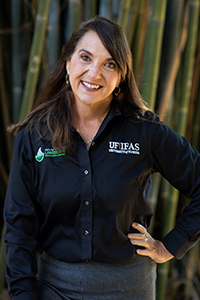Wendy's Wanderings
May 11, 2022
Share the Love of Gardening
"April showers bring May flowers" is a phrase gardeners use often. This year the spring rains have also awakened the beasts in my yard, namely invasive plants. I battle a few bad actors that over the years have cost me lots of time and money and I am still losing the fight. One that I planted, the blue sky vine (Thunbergia grandiflora), and two more that came with the landscape: skunk vine (Paederia foetida) and Campsis radicans, the orange trumpet vine.
Blue sky vine is labeled "high invasion risk" on the UF/IFAS Assessment of Non-Native Plants in Florida's Natural Areas. Skunk vine is on the USDA noxious plants list and prohibited in Florida. That's even more extreme than invasive. But wait, you say! Orange trumpet vine is native to Florida, how can it be invasive?
Managing invasive plants costs Florida an estimated 80 million dollars per year and the figure is growing. Their environmental impacts are huge, as they can permanently eliminate native species and reduce Florida's biodiversity. As the problem has grown, the language and terminology around invasive plants has become more complicated over the years.
Luckily for us, a team of IFAS researchers and extension agents have put together new invasive species terminology that will help to reduce confusion, misuse, and misinterpretation. The paper in the Journal of Extension by Dr. Basil Ianonne et al, called "Invasive Species Terminology: Standardizing for Stakeholder Education," proposes the following seven terms and their definitions:
Native — A species that occurs naturally in a specified geographic area.
Nonnative — A species that does not occur naturally in a specified geographic area.
Introduced — A species brought to a new geographic area intentionally or unintentionally by humans.
Established — A species having a self-sustaining and reproducing population in a specified geographic area without the need for human intervention. Applies to both native and nonnative species.
Invasive — A species that (a) is nonnative to a specified geographic area, (b) was introduced by humans (intentionally or unintentionally), and (c) does or can cause environmental or economic harm or harm to humans.
Nuisance — An individual or group of individuals of a species that causes management issues or property damage, presents a threat to public safety, or is an annoyance. Can apply to both native and nonnative species.
Range change — The circumstance of a species' current/existing range growing, shrinking, or shifting over time. This change can happen to native and nonnative species with or without human assistance.
Iannone et. al also recommend not using the phrases native invasive, invasive exotic, invasive weed, alien, foreign, or nonindigenous to describe problem species. While these words are familiar to us, they are vague and may complicate the issue. It is the researchers' intent that this new terminology will help to increase understanding and reduce the negative impacts of invasive species.
Using the proposed terms then, my blue sky vine and skunk vine are considered invasive. The word to describe my native trumpet vine that is currently trying to eat my house is nuisance. I am inviting Master Gardener Volunteers to adopt these terms and continue to be the source of cutting-edge invasive species information for Florida's gardening communities.
-- Wendy Wilber

